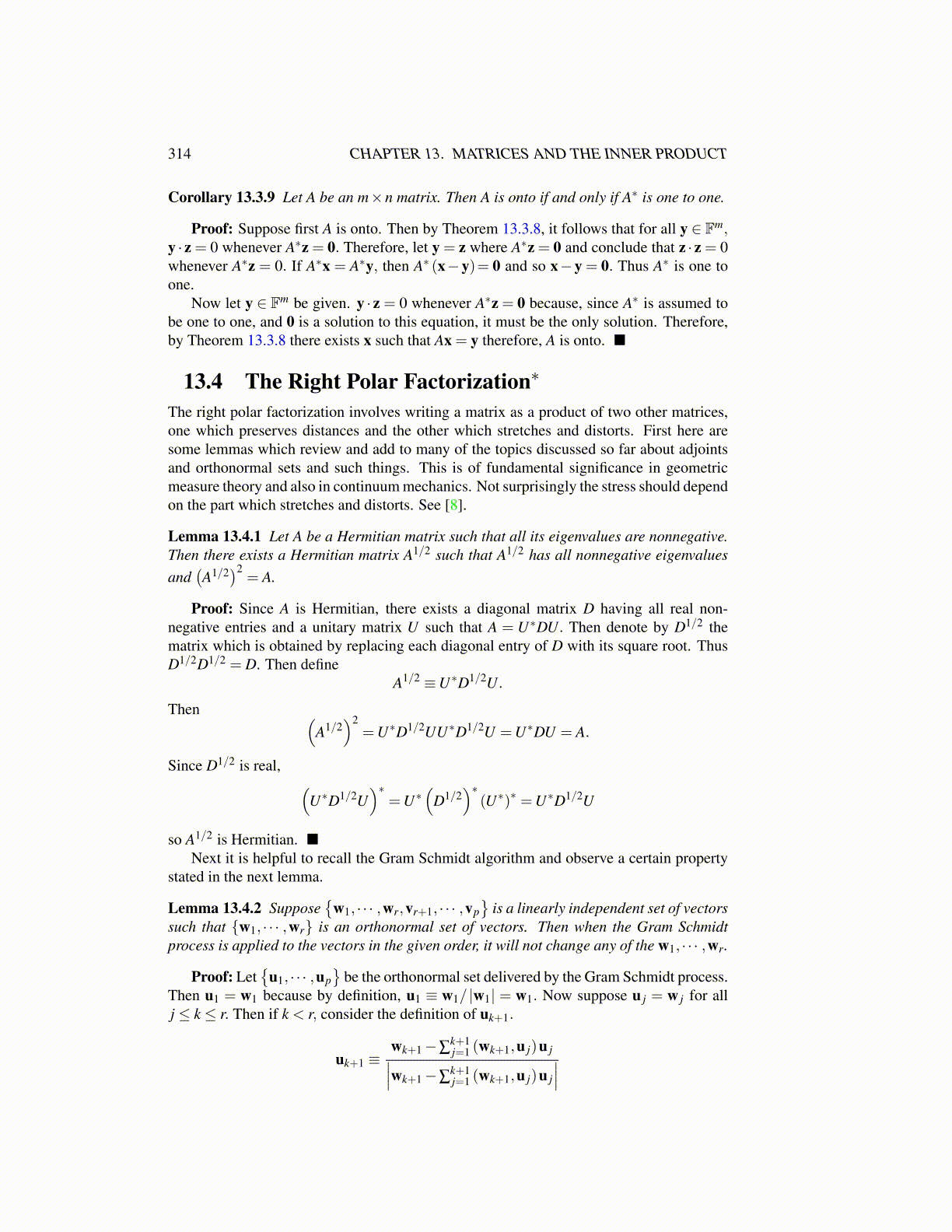
314 CHAPTER 13. MATRICES AND THE INNER PRODUCT
Corollary 13.3.9 Let A be an m×n matrix. Then A is onto if and only if A∗ is one to one.
Proof: Suppose first A is onto. Then by Theorem 13.3.8, it follows that for all y ∈ Fm,y · z = 0 whenever A∗z = 0. Therefore, let y = z where A∗z = 0 and conclude that z · z = 0whenever A∗z = 0. If A∗x = A∗y, then A∗ (x−y)= 0 and so x−y = 0. Thus A∗ is one toone.
Now let y ∈ Fm be given. y · z = 0 whenever A∗z = 0 because, since A∗ is assumed tobe one to one, and 0 is a solution to this equation, it must be the only solution. Therefore,by Theorem 13.3.8 there exists x such that Ax = y therefore, A is onto. ■
13.4 The Right Polar Factorization∗
The right polar factorization involves writing a matrix as a product of two other matrices,one which preserves distances and the other which stretches and distorts. First here aresome lemmas which review and add to many of the topics discussed so far about adjointsand orthonormal sets and such things. This is of fundamental significance in geometricmeasure theory and also in continuum mechanics. Not surprisingly the stress should dependon the part which stretches and distorts. See [8].
Lemma 13.4.1 Let A be a Hermitian matrix such that all its eigenvalues are nonnegative.Then there exists a Hermitian matrix A1/2 such that A1/2 has all nonnegative eigenvaluesand
(A1/2
)2= A.
Proof: Since A is Hermitian, there exists a diagonal matrix D having all real non-negative entries and a unitary matrix U such that A = U∗DU. Then denote by D1/2 thematrix which is obtained by replacing each diagonal entry of D with its square root. ThusD1/2D1/2 = D. Then define
A1/2 ≡U∗D1/2U.
Then (A1/2
)2=U∗D1/2UU∗D1/2U =U∗DU = A.
Since D1/2 is real, (U∗D1/2U
)∗=U∗
(D1/2
)∗(U∗)∗ =U∗D1/2U
so A1/2 is Hermitian. ■Next it is helpful to recall the Gram Schmidt algorithm and observe a certain property
stated in the next lemma.
Lemma 13.4.2 Suppose{
w1, · · · ,wr,vr+1, · · · ,vp}
is a linearly independent set of vectorssuch that {w1, · · · ,wr} is an orthonormal set of vectors. Then when the Gram Schmidtprocess is applied to the vectors in the given order, it will not change any of the w1, · · · ,wr.
Proof: Let{
u1, · · · ,up}
be the orthonormal set delivered by the Gram Schmidt process.Then u1 = w1 because by definition, u1 ≡ w1/ |w1| = w1. Now suppose u j = w j for allj ≤ k ≤ r. Then if k < r, consider the definition of uk+1.
uk+1 ≡wk+1−∑
k+1j=1 (wk+1,u j)u j∣∣∣wk+1−∑k+1j=1 (wk+1,u j)u j
∣∣∣